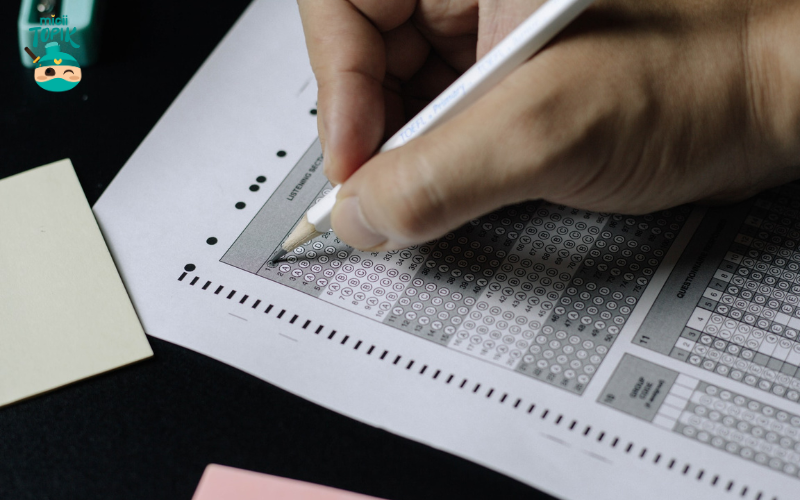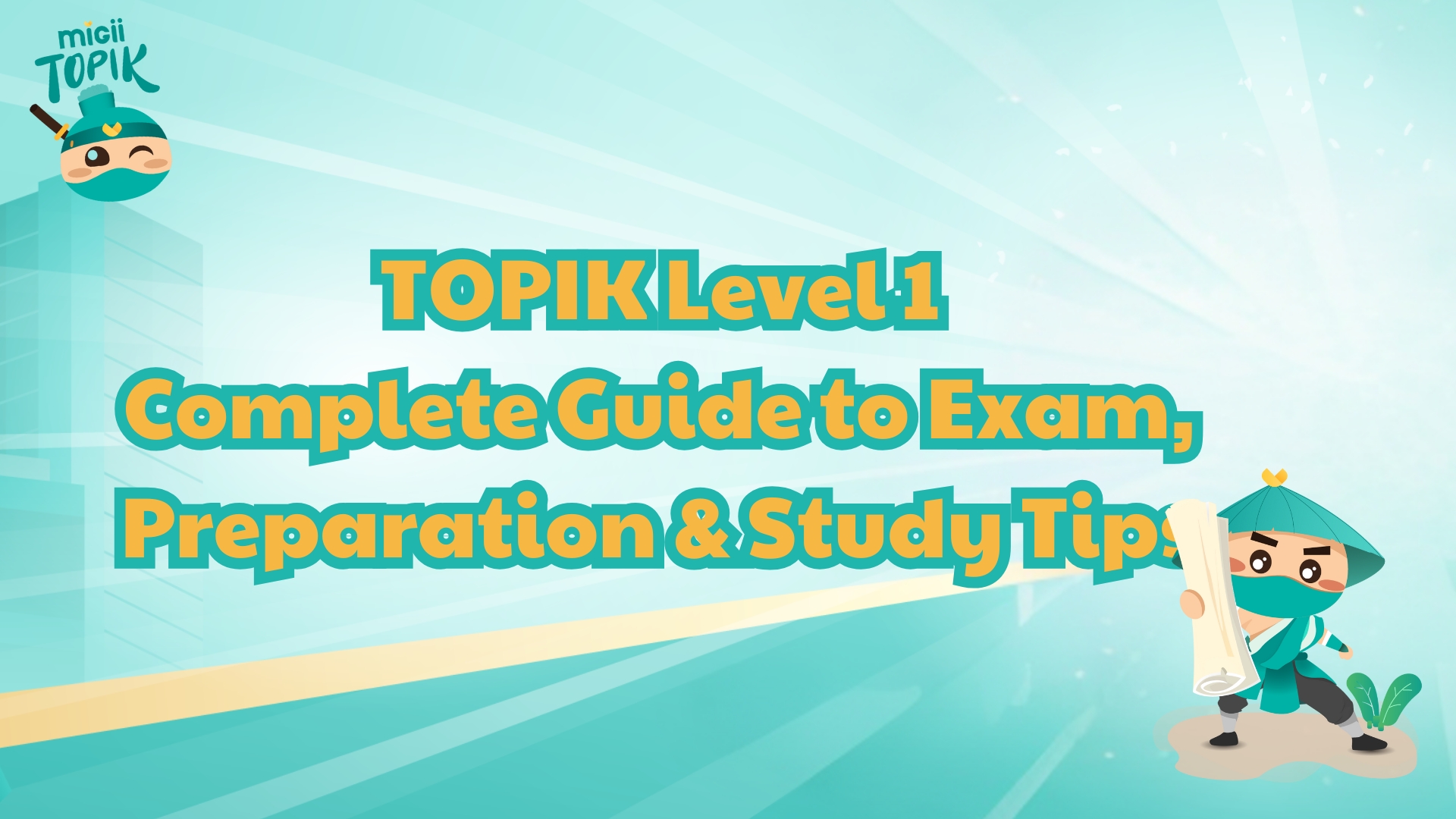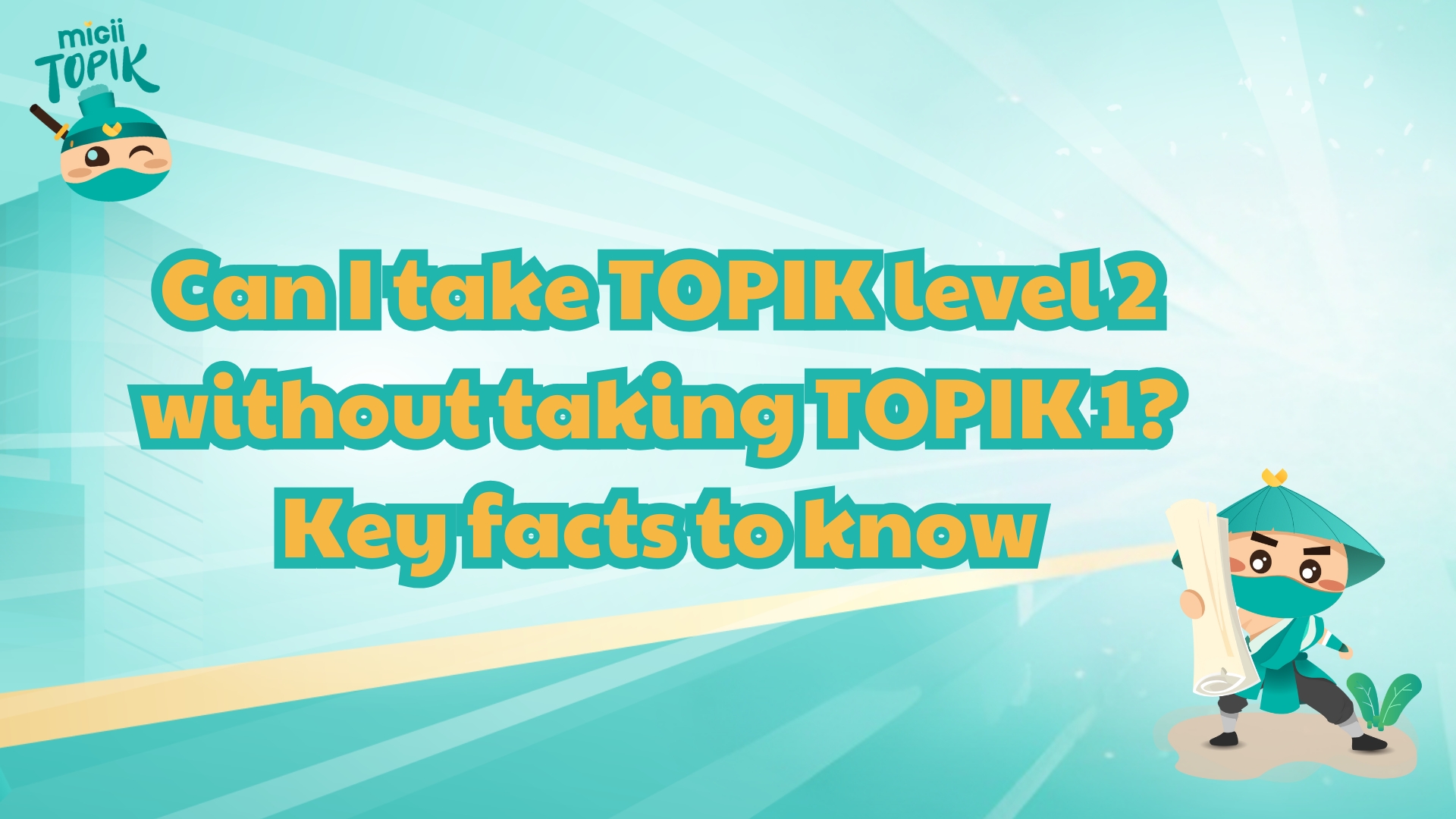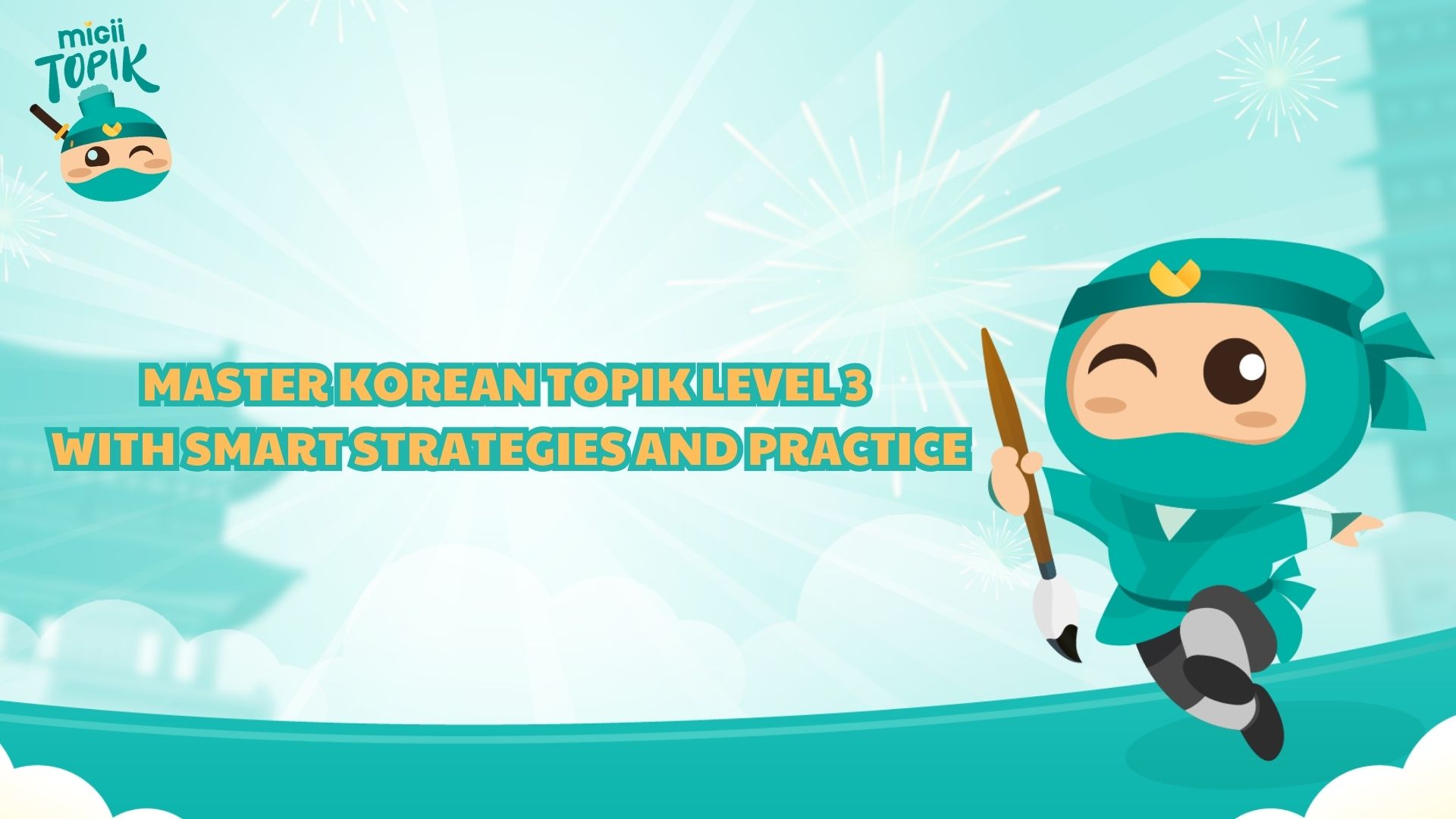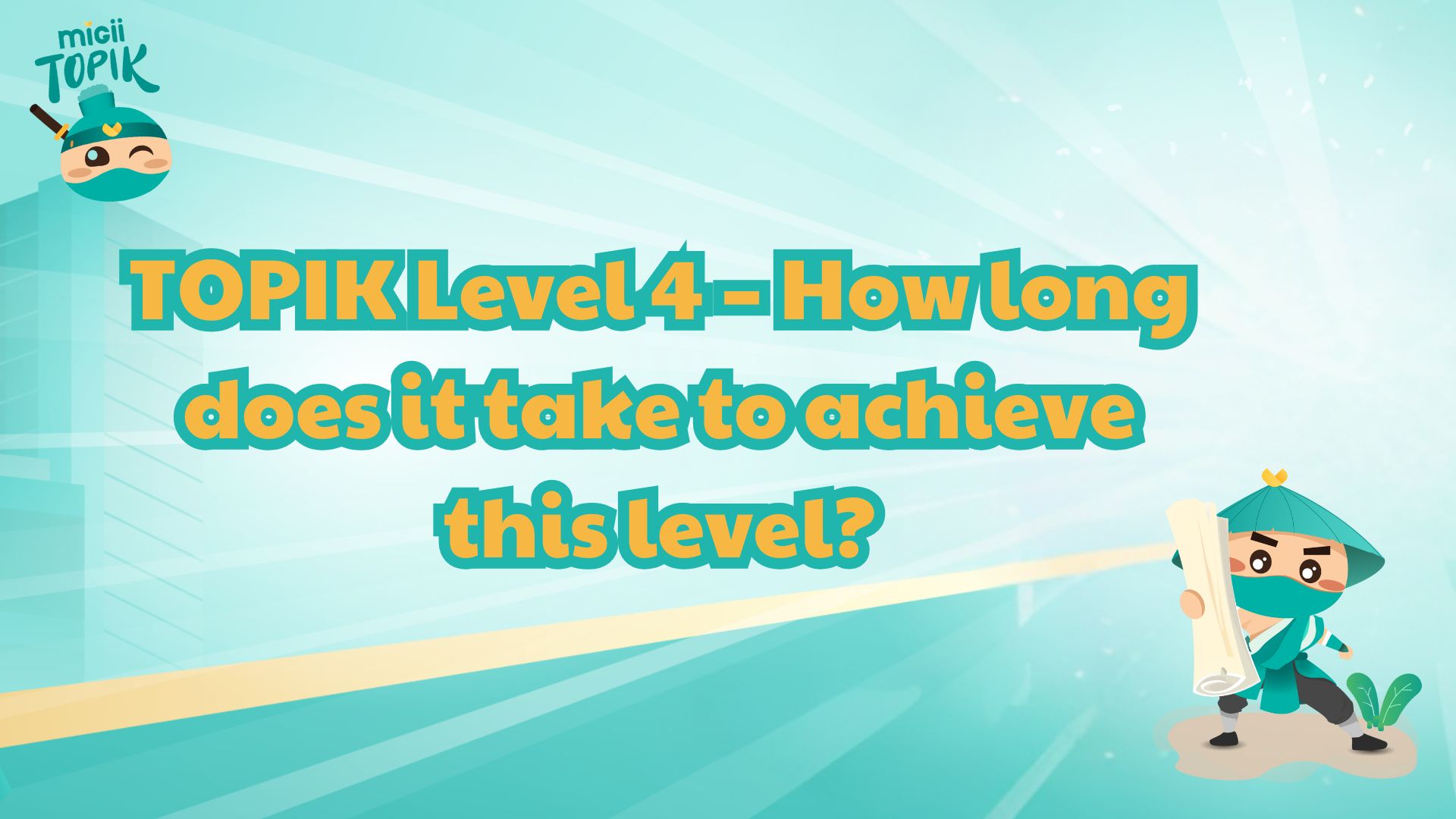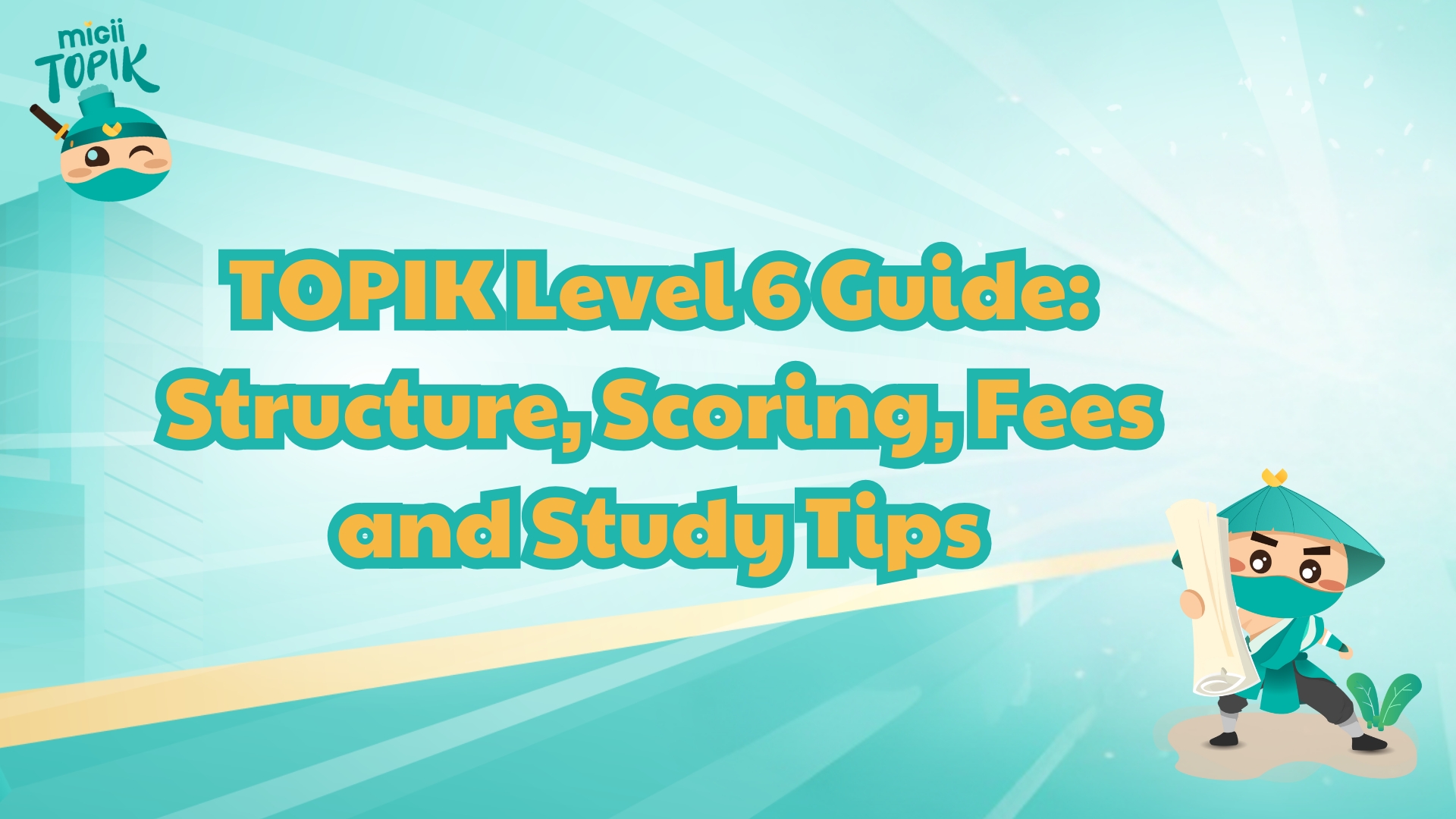The TOPIK exam plays an important role in your Korean learning journey because it helps you understand your actual level and set clear goals for study abroad or work. When you know the test structure, the scoring method and the registration process, you can build a focused study plan for each level. During this process, you can also use learning tools from Migii to support your preparation.

TOPIK exam
Overview of the Korean test TOPIK
TOPIK is a standardised Korean proficiency test for non-native learners that measures Korean language ability across various academic and real-life contexts.
What is the TOPIK exam?
The TOPIK exam, also known as the Test of Proficiency in Korean (한국어능력시험), is a Korean language test for non-native speakers. The exam is organised every year by the National Institute for International Education under the Ministry of Education Science and Technology of Korea.
The test is designed to measure your Korean skills in reading, writing and listening. Its structure is divided into different levels to show the language ability of each candidate in a clear way. Each level has its own requirements for vocabulary and expression that match the goals of the assessment.
Who should take the Korean TOPIK exam?
TOPIK is designed for people who use Korean as a second language and supports many goals in study and career.
- International students: These are students who plan to study at colleges or universities in Korea and need to prove their Korean language ability.
- Job applicants: These are people who want to work for Korean companies or organisations and need to show their language skills in their job applications.
- Independent Korean learners: These are learners who study on their own or outside the formal system and want to check their level through a standard test.
- Visa or scholarship applicants: These are people who need to prove their Korean proficiency for visa procedures, scholarship applications or other related administrative requirements.
The purpose of the Korean language test TOPIK
The value of the TOPIK exam practice is not only to measure language level but also to support important goals in education admissions and administrative procedures in Korea. The main purposes include the following.
- The exam helps guide Korean learning for the international community and overseas Koreans. TOPIK builds a clear standard system that helps learners develop their language skills in an organised way.
- TOPIK uses a standard scoring system to measure Korean proficiency. This clear evaluation process helps learners understand their level and set suitable study goals.
- TOPIK results are used for university admissions in Korea. Many Korean companies and organisations inside and outside Korea also use this certificate to assess the language skills of applicants during recruitment.
- The TOPIK certificate is required in many procedures in Korea, such as job applications, visa applications, study abroad processes or scholarship applications. It serves as an official reference to confirm Korean proficiency in immigration documents and programmes related to education and labour.
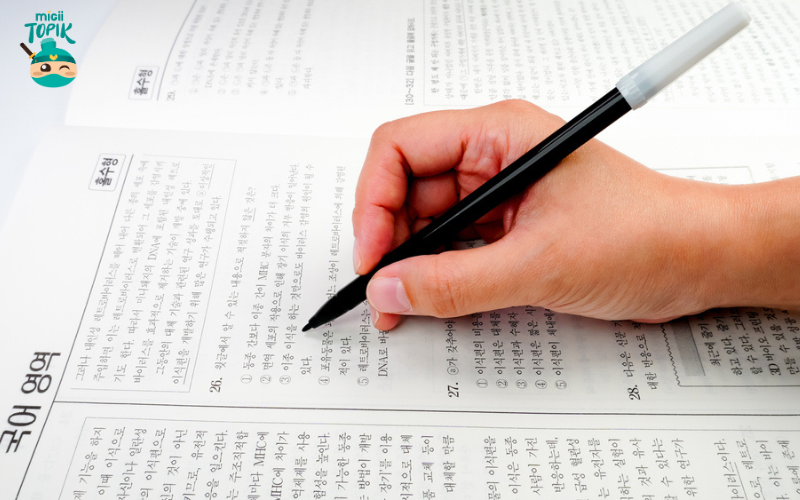
A general overview of the TOPIK Korean proficiency test
Levels and scoring for each skill
The Korean TOPIK test is divided into 2 main types. TOPIK I is the basic level and includes Grades 1 and 2. TOPIK II covers the intermediate to advanced levels and includes Grades 3 to 6.
|
TOPIK level |
Grade |
Minimum score |
Maximum total score |
|
TOPIK I |
Grade 1 |
80 to 139 points |
200 points |
|
Grade 2 |
From 140 points and above |
200 points |
|
|
TOPIK II |
Grade 3 |
120 to 149 points |
300 points |
|
Grade 4 |
150 to 189 points |
300 points |
|
|
Grade 5 |
190 to 229 points |
300 points |
|
|
Grade 6 |
From 230 points and above |
300 points |
Skill-based levels and scoring criteria in the TOPIK Korean practice test
Test structure and skill requirements of the Korean TOPIK
The TOPIK test structure is designed to evaluate listening, reading and writing abilities along with the overall Korean language proficiency of learners at each level.
Test structure and timing for each section
Understanding the test structure and timing for each skill helps learners build a suitable test strategy and prepare more confidently for the TOPIK exam.
|
Level |
Test session |
Skill (Duration) |
Number of questions |
Format |
Total time |
|
TOPIK I |
One session |
Listening for 40 minutes |
30 questions |
Multiple choice |
100 minutes |
|
Reading 60 minutes |
40 questions |
Multiple choice |
|||
|
TOPIK II |
Session 1 (110 minutes) |
Listening for 60 minutes |
50 questions |
Multiple choice |
180 minutes |
|
Writing 50 minutes |
4 questions |
Written response |
|||
|
Session 2 (70 minutes) |
Reading 70 minutes |
50 questions |
Multiple choice |
Notes:
- TOPIK I includes 2 parts: listening and reading. Candidates complete both parts in one continuous 110-minute session. All questions are multiple choice.
- TOPIK II has two sessions. The first session includes listening and writing, then candidates have a 30-minute break before taking the reading section in the second session.
Details of the TOPIK II Writing section
The Writing section of TOPIK II consists of 4 questions that require candidates to express their ideas in their own words.
In the first 2 questions, the candidate must fill in the blanks with a word or phrase to complete the sentence in a correct and meaningful way.
The next 2 questions are essay tasks:
- The short essay is about 200 to 300 characters and usually focuses on familiar daily life situations. It may include a few guiding points to help shape the response.
- The long essay ranges from 600 to 700 characters and requires the candidate to clearly present their opinion or reasoning on a specific topic in Korean with a coherent flow.
Skill expectations for grades 1 to 6
Each TOPIK grade reflects a different level of proficiency, so learners need to understand the skill expectations from Grade 1 to Grade 6 to set clear goals and track their progress accurately.
Grade 1 - Basic daily interaction
Learners at Grade 1 handle very familiar situations such as greetings, shopping, asking for prices or ordering food. They use short sentences and express ideas directly to meet basic needs. Since this is the introductory stage of learning Korean, learners mainly practise simple sentence patterns and common vocabulary used in daily life.
With about 800 basic words, learners can understand the main ideas in simple conversations and respond in familiar contexts. The key goal at this level is to build initial confidence when using Korean so they do not feel confused in everyday real-life situations.
Grade 2 - Essential everyday communication
At Grade 2, learners can talk about more familiar topics such as habits, hobbies, work or daily activities. They can distinguish between polite language used with strangers and casual language used with close friends or family. This helps them choose the right tone for each relationship and avoid unnecessary misunderstandings.
A vocabulary of about 1500 to 2000 words allows learners to understand passages with clear topics and express their ideas more fully. Their ability to follow content is no longer limited to short sentences but extends to longer paragraphs with connected information. This level serves as an important stepping stone toward active communication and handling more complex situations in daily life.
Grade 3 - Practical public communication
Grade 3 of TOPIK focuses on public situations such as making appointments, asking for information, using services, talking with staff or receiving instructions. Learners can maintain conversations and express their intentions more clearly. Their ability to choose the right words for each situation helps communication flow smoothly in crowded or public environments.
At this level, learners understand how to adjust their speech based on purpose and context, for example, when asking for help, refusing a request or asking for detailed information. They can communicate comfortably in most daily situations and handle unexpected requests. This level builds an important foundation before moving on to reading longer and more analytical texts.
Grade 4 - Intermediate reading and analytical skills
Learners in Grade 4 can read and understand news articles or texts that present opinions. They can identify the main idea, arguments and the writer’s intention. Their analytical ability helps them follow content that includes more information and relates to common social issues in Korea.
With a vocabulary of about 3000 to 4000 words, they can discuss medium-level analytical topics such as education, environment, technology or culture. They begin to understand typical Korean thinking and expression patterns, which helps them communicate accurately in basic academic or work settings.
Grade 5 - Professional topic engagement
Learners at Grade 5 use Korean to follow professional content in fields such as economics, society, politics or technical areas. They understand long texts and can discuss work processes or talk about issues in their specialised fields. This level is suitable for people who need Korean in a stable work environment.
A vocabulary range of about 3000 to 4000 advanced words allows them to write reports, present arguments or respond to questions in their work roles. Their ability to distinguish between spoken and written styles helps them adjust their expression for each situation. This level allows learners to join meetings, read documents and deliver their ideas clearly.
Grade 6 - Advanced academic and professional proficiency
Learners at Grade 6 can handle all types of Korean content in academic, professional and social communication. They understand subtle meanings, recognise implied ideas and present their opinions in a clear and structured way. This level reflects near native Korean ability and is suitable for environments that require precise and in-depth interaction.
With over 3000 to 4000 well-mastered words, learners can discuss specialised topics, analyse documents, write essays and express complex ideas. They understand both cultural context and communication styles, allowing them to interact naturally in any situation. This grade is for people who need to use Korean as their main working language.

Structure of the TOPIK practice exam and the required skills
TOPIK schedule, test locations and exam fees
The exam schedule, test locations and fees are essential information that helps learners plan their TOPIK exam in a convenient and well-organised way.
TOPIK 2026 exam timelines
In Korea, there are 6 fixed TOPIK exam sessions held every year. In other countries, and especially in Vietnam, there are 4 sessions held in 3, 4, 10 and 11. The time and place for submitting applications will be announced in detail when the official exam schedule is published.
|
Exam |
Expected registration period |
Exam date |
Result date |
Test location |
|
TOPIK 104 |
09/12/2025 to 15/12/2025 |
11/01/2026 |
12/02/2026 |
Korea |
|
TOPIK 105 |
27/01/2026 to 02/02/2026 |
12/04/2026 |
29/05/2026 |
Korea and international |
|
TOPIK 106 |
10/03/2026 to 16/03/2026 |
17/05/2026 |
25/06/2026 |
Korea and international |
|
TOPIK 107 |
12/05/2026 to 18/05/2026 |
05/07/2026 |
13/08/2026 |
Korea and international |
|
TOPIK 108 |
04/08/2026 to 10/08/2026 |
17/10/2026 |
10/12/2026 |
Korea and international |
|
TOPIK 109 |
01/09/2026 to 07/09/2026 |
15/11/2026 |
22/12/2026 |
Korea and international |
Korean TOPIK practice test locations
Having clear information about TOPIK test locations supports applicants in finding a convenient site and arranging their exam participation without difficulty.
|
Region |
Province or city |
Test venue (English name) |
|
Northern region |
Hanoi |
Dai Nam University |
|
Vietnam National University of Agriculture |
||
|
Hanoi University of Science and Technology |
||
|
Thai Nguyen |
Thai Nguyen University of Technology |
|
|
Hai Phong |
Vietnam Maritime University |
|
|
Phu Tho |
Newton Vinh Phuc International School |
|
|
Central region |
Da Nang |
Dong A University |
|
Southern region |
Ho Chi Minh City |
University of Economics Ho Chi Minh City Nguyen Van Linh campus |
|
University of Economics and Law Ho Chi Minh City |
TOPIK exam Korean fees
The cost of the exam is not fixed and may be updated at different times, so you should confirm the latest official information before completing your registration.
In Korea:
- TOPIK I: 35,000 KRW
- TOPIK II: 40,000 KRW
In Vietnam:
- TOPIK I: 550,000 VND (VAT included)
- TOPIK II: 770,000 VND (VAT included)

TOPIK exam dates, test centers and registration fees
Registration guide, score checking and certificate validity
Information about registration, score checking and certificate validity gives applicants a clear overview of the entire TOPIK Korean exam process.
How to register for the TOPIK exam
Applicants registering in Korea will access the official TOPIK exam website at www.topik.go.kr. The registration fee can be paid by debit card or credit card and may also be paid through bank transfer or online banking.
In other countries, including Vietnam, registration is usually done through the Korean Embassy or the Korean Cultural Center. In Hanoi, online registration is currently supported.
When registering, applicants must prepare the application form, 2 ID photos sized 3x4 cm, and a copy of an identity document such as a national ID card or citizen ID card. Each exam session is limited to 1260 candidates, and only those who register within the official registration period are allowed to take the exam.
On the exam day, applicants must arrive at least 20 minutes before the exam time to complete the verification process. Anyone arriving later than this will not be allowed to enter the exam room. Candidates must bring their admission ticket and the same ID document used during registration.
Exam room regulations do not allow mobile phones inside the test area. If a candidate does not submit their phone to the proctor as instructed, their exam may be cancelled due to a violation of the exam rules.
TOPIK certificate validity
TOPIK scores and certificates are valid for 2 years from the result announcement date. After this period, applicants must retake the exam if they want to continue using the certificate for study, admission, or employment purposes.
How to check your results
The results are published online on www.topik.go.kr. To check the results, applicants must enter their test registration number, candidate number and date of birth to view their detailed scores.
In Korea, the score report will be sent directly to the candidate’s registered address.
For candidates who take the exam overseas, the score report will be sent to the test-organising institution, which will then distribute it to the candidates.

Guide to registration, score inquiry and certificate validity
Study tips and free materials for the Korean TOPIK test practice
Study tips and free learning materials help learners build a clearer preparation plan for the TOPIK exam and improve their chances of achieving their goals.
5 useful TOPIK study tips
The 5 study tips below help you build an effective approach to learning TOPIK that suits each proficiency level.
Clear test strategy
You should answer the easy questions first to build confidence and keep a steady pace. Before starting a practice test, take a quick look at the full structure to divide your time correctly. This approach works for both TOPIK I and TOPIK II because it helps you control your progress in the exam room.
Practice tests from the last 2 years
You should practise with test sets from the most recent 2 years to understand the question style and recognise common patterns. For TOPIK I, you can use study sources that include listening and reading practice to get used to the standard pace. For TOPIK II, you can follow programmes that provide skill-based exercises for listening, reading, writing and speaking to improve speed and writing clarity.
Study vocabulary by level
Vocabulary should be learnt through a clear plan to avoid overload. If you aim for Grade 5 or Grade 6, you should study about 3000 to 4000 words. You can use tools that support level-based vocabulary study on the Migii platform to remember words better, review mistakes and practise with flashcards. Daily study helps you recognise words faster in the listening and reading sections.
Master essential grammar
You need to understand about 150 important grammar patterns to follow sentence structures and meaning accurately. When learning grammar, you can write sample sentences or create simple real-world examples. Regular practice helps you feel more confident when facing questions that require meaning analysis in both TOPIK I and TOPIK II.
Build skills with a structured plan
Listening should be practised by reading the question first and focusing on keywords in the audio. Reading should follow the habit of checking the question before scanning the passage. Writing in TOPIK II requires you to outline your ideas first to ensure clarity. When combined with Migii practice programmes, you will have a clear skill-based study path and can track your progress every day.
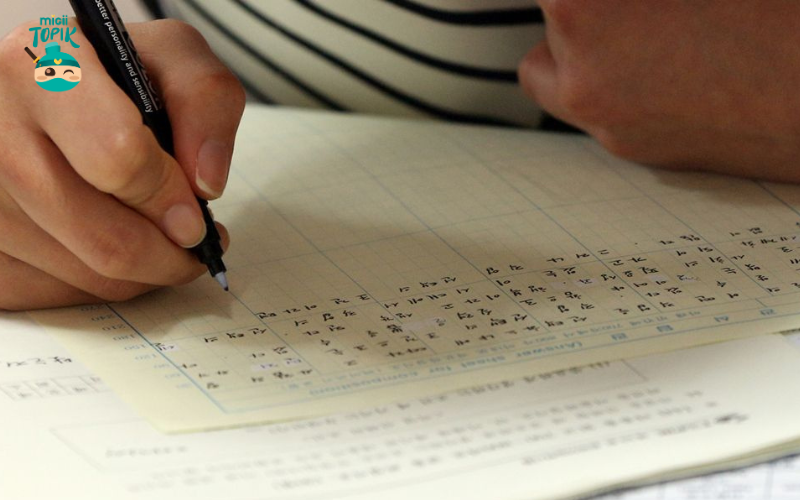
Practical tips for studying for the TOPIK Korean language test
Free study materials compiled for the TOPIK exam by Migii
Migii provides a free set of study materials that help learners prepare for the TOPIK exam with a clear plan that matches each proficiency level. Each material has its own strengths and is suitable for both beginners and advanced learners.
TOPIK II Vocabulary in 50 Days
This book helps you build the essential vocabulary for TOPIK II in 50 days. The vocabulary is grouped by familiar topics that often appear in the exam, which makes it easier to remember and apply in the listening, reading and writing sections.
Download the free PDF file here:
Complete Guide to the TOPIK I (Basic)
This book focuses on the full structure needed for TOPIK I, including the listening section and the reading section. Each question type is explained with clear examples that help learners understand how to choose the correct answer. This material is suitable for beginners or learners who want to achieve stable scores in a short time.
Download the free PDF file here:
Hot TOPIK II Reading
This book trains reading skills based on the exact formats used in TOPIK II. The content includes passages with similar length and difficulty as the real exam, which helps you improve your ability to identify main ideas and analyse questions quickly. It is a helpful resource for anyone who wants to strengthen their reading score in a sustainable way.
Download the free PDF file here:
Conclusion
The TOPIK exam provides a clear measurement system that helps Korean learners identify their level and choose the right study path for both education and work. When you understand the test structure, the requirements for each grade and the registration process, you can manage your study plan with more control. If you want to strengthen your skills step by step, explore Migii TOPIK to continue improving your level in a steady way.
